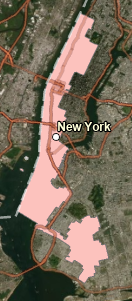Lab 6 [GIS6005]: Bivariate Choropleth Mapping
The map above demonstrates the use of bivariate choropleth mapping to demonstrate patterns in the United States related to obesity and physical inactivity, as highlighted in the close-up of the legend provided here:
In order to prepare data for bivariate choropleth mapping, two related variables must first be normalized. In this example, the variables have been normalized using the population of each county.
Next, each variable must be independently classed into an appropriate number of bins. The quantile classification method was selected in the example above so that the data values for each of the variables were distributed in equal numbers across the data bins - this meant there were no bins with too few or too many data points. Three classes were selected for each variable in this example to intuitively align with low, medium, and high rates of of physical inactivity in a population, as well as low, medium, and high rates for obesity in a population. Three classes for each variable also yielded nine classes in the final bivariate choropleth mapping legend, which is typically the highest number used to make visual interpretation easier for the reader.





Comments
Post a Comment